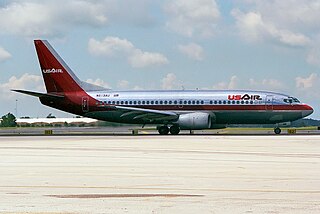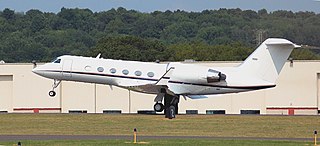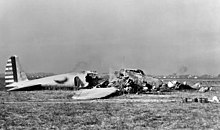
Delta Air Lines Flight 1141 was a scheduled domestic passenger flight between Dallas Fort Worth International Airport, Texas, and Salt Lake City International Airport, Utah. On August 31, 1988, the flight, using a Boeing 727-200 series aircraft, crashed during takeoff at Dallas Fort Worth International Airport, resulting in 14 deaths and 76 injuries among the 108 on board.

United Airlines Flight 585 was a scheduled passenger flight on March 3, 1991, from Denver to Colorado Springs, Colorado, carrying 20 passengers and 5 crew members on board. The plane experienced a rudder hardover while on final approach to runway 35 at Colorado Springs Municipal Airport, causing the plane to roll over and enter an uncontrolled dive. All 25 people on board the Boeing 737 were killed on impact.

On the evening of February 1, 1991, USAir Flight 1493, a Boeing 737-300, collided with SkyWest Airlines Flight 5569, a Fairchild Swearingen Metroliner turboprop aircraft, upon landing at Los Angeles International Airport (LAX). As Flight 1493 was on final approach, the local controller was distracted, though air traffic was not heavy at LAX, by a series of abnormalities, including a misplaced flight progress strip and an aircraft that had inadvertently switched off the tower frequency. The SkyWest flight was told to taxi into takeoff position, while the USAir flight was landing on the same runway.

USAir Flight 5050 was a passenger flight that crashed on takeoff from LaGuardia Airport in Queens, New York. As the plane took off from LaGuardia's runway 31, the plane drifted to the left. After hearing a loud bang, the pilots attempted to reject the takeoff, but were unable to stop the plane short of the end of the runway. The plane continued past the end of the runway and plunged into Bowery Bay. Two passengers were killed.

Gimli Industrial Park Airport is a civilian airport and former military field located 2 nautical miles west of Gimli, Manitoba, Canada.

Comair Flight 5191 was a scheduled United States domestic passenger flight from Lexington, Kentucky, to Atlanta, Georgia. On the morning of August 27, 2006, at around 06:07 EDT, the Bombardier Canadair Regional Jet 100ER crashed while attempting to take off from Blue Grass Airport in Fayette County, Kentucky, 4 miles west of the central business district of the city of Lexington.

Air Moorea Flight 1121 was a de Havilland Canada DHC-6 Twin Otter which crashed into the ocean shortly after takeoff from Moorea Airport on Moorea Island in French Polynesia on 9 August 2007, killing all 20 people on board.
Aero Valley Airport is a privately owned, public use airport 3 nautical miles (5.6 km) northwest of Roanoke, in Denton County, Texas, United States.

Continental Airlines Flight 1404 was a Continental Airlines domestic flight from Denver International Airport in Denver, Colorado, to George Bush Intercontinental Airport in Houston, Texas. On the evening of December 20, 2008, the flight crashed while taking off from Denver, resulting in two critical injuries, 36 noncritical injuries, and a hull loss of the Boeing 737-524 aircraft.

On December 3, 1990, two Northwest Airlines jetliners collided at Detroit Metropolitan Wayne County Airport. Flight 1482, a scheduled Douglas DC-9-14 operating from Detroit to Pittsburgh International Airport, taxied by mistake onto an active runway in dense fog and was hit by a departing Boeing 727 operating as Flight 299 to Memphis International Airport. One member of the crew and seven passengers of the DC-9 were killed.

USAir Flight 427 was a scheduled flight from Chicago's O'Hare International Airport to Palm Beach International Airport, Florida, with a stopover at Pittsburgh International Airport. On Thursday, September 8, 1994, the Boeing 737 flying this route crashed in Hopewell Township, Pennsylvania while approaching Runway 28R at Pittsburgh, which was USAir's largest hub at the time.

In aviation, a preflight checklist is a list of tasks that should be performed by pilots and aircrew prior to takeoff. Its purpose is to improve flight safety by ensuring that no important tasks are forgotten. Failure to correctly conduct a preflight check using a checklist is a major contributing factor to aircraft accidents.

The Air Indiana Flight 216 crash occurred on December 13, 1977, at 19:22 CST, when a Douglas DC-3, registration N51071 carrying the University of Evansville basketball team, the Evansville Purple Aces, crashed on takeoff at the Evansville Regional Airport in Evansville, Indiana. The aircraft lost control and crashed shortly after lift-off. The plane was on its way to Nashville International Airport, taking the team to play the Middle Tennessee Blue Raiders in Murfreesboro, Tennessee.

On 7 July 2013, a single-engine de Havilland Canada DHC-3 Otter, operated by air charter company Rediske Air, crashed on take-off at Soldotna Airport, Alaska. The sole crewmember and all nine passengers on board were killed. The crash was attributed to improper loading.

Ryan International Airlines Flight 590 was a cargo flight carrying mail for the United States Postal Service from Greater Buffalo International Airport (BUF) in Buffalo, New York, to Indianapolis International Airport (IND) in Indiana, with a stopover at Cleveland Hopkins International Airport (CLE) in Cleveland, Ohio. On February 17, 1991, the McDonnell Douglas DC-9-15RC operating the flight crashed on takeoff from Cleveland during icing conditions. Both pilots, the aircraft's only occupants, were killed. The National Transportation Safety Board (NTSB) determined that the causes of the crash were the flight crew failing to deice their aircraft, and the inexperience of the Federal Aviation Administration (FAA), McDonnell Douglas, and Ryan International Airlines with icing condition on DC-9-10 aircraft.

Ameristar Charters Flight 9363 was a charter flight from Willow Run Airport to Washington Dulles Airport on March 8, 2017, which rejected takeoff and overran the runway. The crash was caused by a jammed elevator, which was damaged by high winds the day before the crash.

American millionaire philanthropist Lewis Katz and six others were killed in a Gulfstream IV crash in Bedford, Massachusetts, on 31 May 2014. Katz, the co-owner of The Philadelphia Inquirer and several major sports teams, had chartered the twinjet for a day trip from Atlantic City, New Jersey, to Concord, Massachusetts. In addition to several personal friends, he had also invited Edward G. Rendell, a former governor of Pennsylvania, who was unable to accept.

















